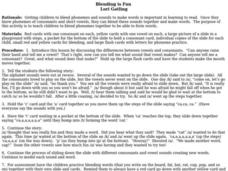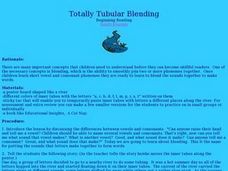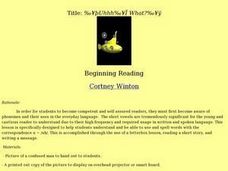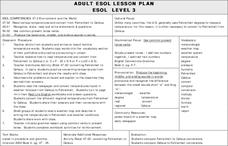Curated OER
What's Behind the Creaky Door?
First graders are introduced to the concept that letters stand for the mouth moves that we make when sounds are made. They practice making the /e/ sound and compare it to the sound a creaky door makes and then try saying the tongue...
Curated OER
The Iddy Biddy Igloo
Students identify and recognize the short vowel /i/ in spoken and written words. They identify the short /i/ sound and its letter symbol. They say a tongue twister emphasizing the short /i/ sound, and identify the words with /i/ in the...
Curated OER
Doctor Check-Up
Students recognize the short vowel o in written and spoken language. Through matching activities, students discriminate the short vowel o from the long vowel o. They associate the phoneme with its letter representation and identify the...
Curated OER
E-E-E-E-Extra E-E-E-E-Effort
Students listen to a tongue twister emphasizing the short e sound. They practice writing the letter e and attaching different words with that sound to it. They listen to a book about a dog that enhances the letter e. They write a...
Curated OER
Iggy and the Icky Sticky Inchworm
Students read and spell words. They have to recognize that letters stand for phonemes and spellings map out spoken words. Long and short vowels are hard to recognize and this lesson focuses on that. The short i is taught in the...
Curated OER
Icky Fingers
Students are introduced to digraphs so they can match letters to their phonemes. They recognize the short vowel i=/i/ in both spoken and written words by practicing reading and spelling words containing /i/. Elkonin Letter Boxes are...
Curated OER
Say Ahh!!
Students identify the short /o/ sound in spoken words, and recognize the letter symbol /o/. They say a tongue twister emphasizing words with the short /o/ sound. They then listen to the story "In the Big Top" and identify the words...
Curated OER
Everyone is Reading
Students study /e/ in both written and spoken words using a tongue twister and letterbox activities. They recite a tongue twisters and make words using letterboxes. Next, they read "Red Gets Fed" and find words that contain the /e/...
Curated OER
Icky Sticky Inchworm
Students recognize the short vowel i in written and spoken language. Through matching activities, they discriminate the short vowel /i/ from other vowel sounds. Students associate the phoneme with its letter representation and identify...
Curated OER
Blending is Fun
Use a poster picture of a slide to illustrate the blending of phonemes in words. First show your youngsters basic examples like cat and cap. Then have learners work in pairs to create some blends of their own! Provide words for them to...
Curated OER
Bless You
Students practice recognizing the phoneme /a/ in spoken and written words as well as by symbol. They interact with the book, "The Cat Nap," from Educational Insights and the Dr. Seuss book, "ABC's Book." Each student also plays a memory...
Curated OER
Segmenting and Blending Words
Students listen to words, then segment them into sounds, and hear sounds and blend them into words.
Curated OER
"Ca...Ca...Ca...Caterpillar Blending"
Students improve blending skills. They produce many individual short utterances and mouth moves (phonemes) into one long utterance (words) and create their own blending caterpillar. They draw a picture of a caterpillar with three...
Curated OER
Totally Tubular Blending
Students practice a wide variety of techniques and strategies to strengthen their blending skills to form words and read. They read "A Cat Nap" and interact with different colors of inner tubes with the letters "a, c, b, d, f, l, m, p,...
Curated OER
Uhhh..What?
Students identify and become competent and in reading the letter u, pronounced /uh/. They also use and spell words with the correspondance u = /uh/ by the use of a letterbox lesson, reading a short story, and writing a message.
Curated OER
I Feel the Need....The Need for Speed!
Students first learn to decode when learning to read. Decoding each letter and phoneme in a sentence or even a short text takes a considerable amount of time. Students must drill to progress in the pace and level of their reading. In...
Curated OER
Shhh, Be Quiet, We're Trying to Read
Students practice spelling, sounding out, and identifying the "sh" digraph. Students listen as the teacher reads a tongue twister emphasizing words with the "sh" sound. Students listen to the story "Is Joe Home?" and identify the words...
Curated OER
Open Your Mouth and Say Ahh!
Students identify and hear distinct sounds in spoken and written language. Then they develop a connection between phonemes and their letter symbols which is a key factor in the success of learning how to read and write. Students also...
Curated OER
I Can Read With Expression
Young scholars practice reading fluently and expressively through the use of various strategies. After reviewing chunking, decoding, and rereading, students complete an initial read of a novel text. They create a deck of expression cards...
Curated OER
IIII---L-lll-ke---IIII-ke-and-M-IIII-ke
Learners recognize the letter combination i_e by reading and spelling words with letter boxes in this lesson. They say a tongue twister which emphasizes the long /i/ silent /e/ combination. They then listen the story "Kite Day at Pine...
Curated OER
What Do Seals Eat?
Learners recognize the ea=/E/ correspondence in spoken and written words. They participate in a group letterbox lesson. In groups of two, they practice reading with each other, taking turns reading one page at a time, identifying the...
Curated OER
Temperature Conversions
Young scholars discuss the different between the English system of measurement and the metric system. Working ins mall groups, students read the weather map. They convert temperatures from one measurement system to another.
Curated OER
Uhh I don't know!
Students engage in an emergent literacy lesson in order to work on the skill of phonem ic awareness. The use of flashcards is essential for the instruction of the lesson. Students match the card with its beginning phoneme.
Curated OER
ADULT ESOL LESSON PLAN--Family and Parenting
Students explore all the specific requirements that must be followed in order to enroll children in school/day care aged 6-16. In addition, they review the importance of regular school attendance.

























